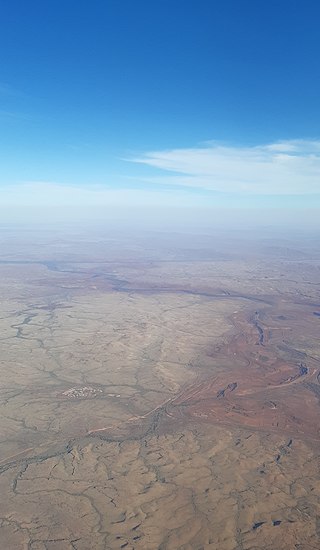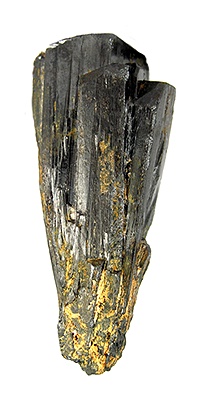Related Research Articles

Coltan is a dull black metallic ore from which the elements niobium and tantalum are extracted. The niobium-dominant mineral in coltan is columbite, and the tantalum-dominant mineral is the tantalite.

Goldsworthy is a former mining town in Western Australia, east of Port Hedland and located in the Shire of East Pilbara. It was the first iron ore mine in the Pilbara region of Western Australia.

Mining in Western Australia, together with the petroleum industry in the state, accounted for 94% of the State's and 46% of Australia's income from total merchandise exports in 2019–20. The state of Western Australia hosted 123 predominantly higher value and export-oriented mining projects and hundreds of smaller quarries and mines. The principal projects produced more than 99 per cent of the industry's total sales value.

National Atomic Company Kazatomprom Joint Stock Company (Kazatomprom) is the world’s largest producer and seller of natural uranium, providing over 40% of global primary uranium supply in 2019 from its operations in Kazakhstan. Kazatomprom's uranium is used for the generation of nuclear power around the world.

The mining industry of the Democratic Republic of the Congo produces copper, diamonds, tantalum, tin, gold, and more than 63% of global cobalt production. Minerals and petroleum are central to the DRC's economy, making up more than 95% of value of its exports.
Burundi is a producer of columbium (niobium) and tantalum ore, tin ore, and tungsten ore, and some deposits of gold which are designated for export. Burundi has resources of copper, cobalt, nickel, feldspar, phosphate rock, quartzite, and rare reserves of uranium, and vanadium. The country is also a producer of limestone, peat, sand and gravel for domestic consumption and as building materials. As of 2005, manufacturing accounted for 8% of the country's gross domestic product.

Mining is important to the economy of Ethiopia as a diversification from agriculture. Currently, mining comprises only 1% of GDP. Gold, gemstones, and industrial minerals are important commodities for the country's export-oriented growth strategy.
Rosslyn Hill Mining Pty Ltd operates Paroo Station Mine at Wiluna in Western Australia.
The mineral industry of Mozambique plays a significant role in the world's production of aluminium, beryllium, and tantalum. In 2006, Mozambique's share of the world's tantalum mine output amounted to 6%; beryllium, 5%; and aluminium, 2%. Other domestically significant mineral processing operations included cement and natural gas.

The Mount Whaleback mine, officially the Newman West operation, is an iron ore mine located in the Pilbara region of Western Australia, six kilometres west of Newman.

Iron ore mining in Western Australia, in the 2018–19 financial year, accounted for 54 percent of the total value of the state's resource production, with a value of A$78.2 billion. The overall value of the minerals and petroleum industry in Western Australia was A$145 billion in 2018-19, a 26 percent increase on the previous financial year.
The Jimblebar mine is an iron ore mine located in the Pilbara region of Western Australia, 41 kilometres east of Newman.
The Wodgina mine is an exhausted iron ore mine located in the Pilbara region of Western Australia, 90 kilometres south of Port Hedland.

The Yandi mine is an iron ore mine located in the Pilbara region of Western Australia, 90 kilometres north-west of Newman. It should not be confused with Rio Tinto's nearby Yandicoogina mine, which is also sometimes shortened to Yandi.

Mining in Rwanda consists of extracting such minerals as tin, tantalum, and tungsten. In 2020, Rwanda earned about US$733m from mineral exports, making mining the biggest source of export revenues after tourism.

Coltan is the colloquial name for the mineral columbite-tantalum ("col-tan"); it is sometimes incorrectly used as shorthand for tantalite, a metallic ore from which the very similar elements niobium, also known as columbium, and tantalum are extracted. In the early 21st century coltan mining was associated with human rights violations such as child labour, systematic exploitation of the population by governments or militant groups, exposure to toxic chemicals and other hazards as a result of lax environmental protection, and general safety laws and regulations.
The Kenticha mine is a tantalum and lithium mine located in the Oromia Region of Southern Ethiopia. It is one of the largest tantalum reserves in the country, having estimated reserves of 116 million tonnes of ore grading 0.02% tantalum.

The mining industry of Yemen is at present dominated by fossil mineral of petroleum and liquefied natural gas (LNG), and to a limited extent by extraction of dimension stone, gypsum, and refined petroleum. Reserves of metals like cobalt, copper, gold, iron ore, nickel, niobium, platinum-group metals, silver, tantalum, and zinc are awaiting exploration. Industrial minerals with identified reserves include black sands with ilmenite, monazite, rutile, and zirconium, celestine, clays, dimension stone, dolomite, feldspar, fluorite, gypsum, limestone, magnesite, perlite, pure limestone, quartz, salt, sandstone, scoria, talc, and zeolites; some of these are under exploitation.

The Mtwara Development Project is a major infrastructure development project involving southern Tanzania, northern Mozambique, eastern Malawi and Eastern Zambia. The goal of this project is to provide road, rail and waterway access from the surrounding region to the Port of Mtwara. The region and the corridor has been neglected by the respective governments for over 40 years and the recent discovery of oil, gas and various minerals has kick started the development of the project. A road and rail link is to be built from the port of Mtwara to Mbamba Bay on Lake Nyasa to link Malawi to the corridor and further road links into Mozambique will facilitate access to northern Mozambique.
References
- ↑ "Tantalum reserves in Canada" (PDF). commerceresources.com. 2013. Archived from the original (PDF) on 2010-12-25. Retrieved 2013-07-07.
- 1 2 3 Melissa Pistilli, Noventa: Marropino Tantalum Mine Producing Once Again, Investingnews.com, 28 April 2010 (accessed on 18 June 2019)
- 1 2 Minerals Yearbook, 2008, V. 3, Area Reports, International, Africa and the Middle East, Government Printing Office, 24 october 2010 ( ISBN 9781411329652). pp.31.2
- 1 2 Tantalite from Marropino, Mozambique may be exported via Quelimane, Macauhub.com.mo, 6 September 2010 (accessed on 18 June 2019)
- 1 2 Minerals Yearbook Area Reports: International Review, 2009, Africa and the Middle East, Government Printing Office, 2011 ( ISBN 9781411329751). pp.32.2
- 1 2 Highland African Mining Company closes mine in Marropino, Mozambique, Macauhub.com.mo, 2 August 2013 (accessed on 18 June 2019)
- ↑ REG - Noventa Limited - New Tantalum Discovery at Marropino [ dead link ], Reuters.com, 24 August 2010 (accessed on 18 June 2019)
- ↑ Noventa ready to make first shipments of tantalum from Marropino mine, Stockopedia.com, 23 August 2010 (accessed on 18 June 2019)
- ↑ Noventa Provides Update on Progress at Marropino, Newswire.ca, 2 February 2012 (accessed on 18 June 2019)
- ↑ Highland African Mining closes Mozambique mine, Miningreview.com, 5 August 2013 (accessed on 18 June 2019)
- ↑ Process Optimisation in the Mining Industry, Gla.ac.uk (accessed on 18 June 2019)
- ↑ Chanel de Bruyn, Noventa seeks to improve tantalum recovery at Moz mine, Miningweekly.com, 23 June 2010 (accessed on 18 June 2019)